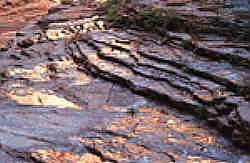New analysis of the remains of two ‘puppies’ dating back more than 14,000 years ago has shown that they are most likely wolves, and not related to domestic dogs, as previously suggested. The genetic analysis also proved that the cubs were sisters at the age of around two months, and like modern day wolves had a mixed diet of meat and plants. Researchers, however, were surprised to see evidence of a wooly rhinoceros as part of their last meals, as…

A new approach without the controversial biotechnology used in GMOs
Rutgers geneticists have devised a new approach to create a more nutritious corn without employing the controversial biotechnology used in genetically modified foods. Instead of adding foreign DNA to the corn, the researchers increased the plant’s ability to produce more of its own naturally occurring protein by adjusting the genetic signals that control the process. The result is a more nutritious and natural fo

While industrial products like chlorofluorocarbons are largely responsible for current ozone depletion, a NASA study finds that by the 2030s climate change may surpass chlorofluorocarbons (CFCs) as the main driver of overall ozone loss.
Drew Shindell, an atmospheric scientist from NASA’s Goddard Institute for Space Studies (GISS) and Columbia University, N.Y., finds that greenhouse gases like methane and carbon dioxide are changing the climate in many ways. Some of those effects include wat

To help the nature to recover from harmful impacts of the mining industry, Svetlana Mesyats and her team from the Geological Institute of the Kola Research Center RAS offer the method, which implies the application of a thin invisible polymeric film onto the soil surface and provides for a fast and successful minesite recultivation.Polymer Protects Grass
It is not surprising that such a polymeric covering is invented in Apatity. People leaving on the Cola Peninsula often need to dea

The catastrophic flooding in Jakarta in February this year could have been predicted nearly 3 weeks in advance with a new technique being developed by Dr Matt Wheeler and colleagues at the Bureau of Meteorology Research Centre in Australia.
The flooding was caused by large waves of air and clouds, so called Madden-Julian Oscillations (MJOs). Using satellite data Dr Wheeler and co-workers are able to predict the occurrence of MJOs, which take about one month to move across the Indian basin a

A shower of matter from space millions of years ago could have led to drastic changes in the Earth’s climate, followed by the extinction of life on a massive scale, which also killed off the dinosaurs. This at least is a theory put forward by scientists from the University of Bonn. Normally, the solar wind acts as a shield against showers of cosmic particles, which prevents too many energy-rich particles from raining down on our atmosphere. Since 1997 scientists from Bonn, funded by the German Resea

The use of key resources such as forests, fisheries and energy is likely to be unsustainable and threaten the ability of SE Asia to build an environmentally and economically stable future in the face of global change, say a group of international scientists meeting in Bali this week.
In the 1980s the rates of deforestation in Southeast Asia ranged between 60,000 hectare per year in Cambodia and 600,000 hectare per year in Indonesia. Twenty years later it became uncontrollable with larger ran

Greening seems to have increased during the 1980s and 1990s in the northern hemisphere from the arctic regions down to the 35th parallel of latitude (roughly southern Europe). This has been shown by measurements from space satellites. Some observers, however, have doubted the reliability of these measurements. In the latest issue of Science, a research team from the Institute for Climatic Impacts Research in Potsdam, the Max Planck Institute for Biogeochemistry in Jena, and Lund University presents n

The results of a new study suggest that rising temperatures are leaving a mark on the world. According to a report published in the current issue of the journal Science, the first flowering of plants in Britain has changed by as much as 55 days over the past few decades in response to warmer weather. The results, the scientists say, are the “strongest biological signal yet of climatic change.”
Alastair Fitter of the University of York and his father, naturalist Richard Fitter, analyzed 47 y

Findings may lead to more effective regulations for protecting public health
Using data from one of the most comprehensive U.S. air pollution studies ever conducted, scientists at the U.S. Department of Energy’s Brookhaven National Laboratory have identified specific volatile organic compounds (VOCs) as key sources of excess ozone smog in industrial areas of Houston, Texas — which appear to be different from traditional sources of ozone pollution in typical urban areas around the co

Researchers at Imperial College London have just begun a 5-year project to design and build tiny earthquake measuring devices to go to Mars on the 2007 NetLander mission.
Unlike the instruments on next year`s European Mars Express/Beagle II mission, the Marsquake sensors will be the first to look deep inside the planet.
The internal structure of Mars is a key to understanding some fundamental questions about the planet including whether life ever existed there.
The sensors are c

Scientists at the University of Leicester’s Space Research Centre are recreating the hostile environment found on Mars in their laboratory, with a device known as the Martian Environment Simulator (MES). The machine reproduces the temperature, air pressure and unbreathable atmosphere known to exist on Mars. The MES is currently being used to test equipment on the Beagle 2 lander, part of the European Space Agency’s Mars Express Spacecraft and due to arrive on Mars during Christmas 2003. The chance o

Species extinction or `biodiversity loss` has accelerated at an alarming rate over the past century. Although much of the blame has been laid at the door of human activity, biologists are looking at the factors that influence how species-particularly similar species-co-exist, in their efforts to better understand how the balance of species can be maintained.
New research into forest trees by Dr Colleen Kelly of the Division of Ecology and Biodiversity at the University of Southampton has sho

Plymouth researchers will be presenting new research findings at an international conference they are hosting in the city next month.
Professor Paul Worsfold, Co-director of Plymouth Environmental Research Centre (PERC), heads the Plymouth team working on a three-year research project which investigates the role of iron in ocean productivity and climate change. Plymouth is one of 12 European universities taking part in this ‘IRONAGES’ project.
Professor Worsfold commented: “We are

Researchers from the University of East London (UEL) have embarked on a project to investigate the ecology of the atmosphere, one of the last great frontiers of biological exploration on Earth. In an eighteen-month pilot project launched today, a team of microbiologists led by Dr Bruce Moffett aims to discover whether airborne microbes play an active role in forming clouds and causing rain to fall.
The researchers are using a revolutionary `cyclonic cloud catcher`, based on vacuum cleaner te

A plastic “energy flower” that collects solar and wind energy that can then be used to power appliances in the home for free has won a Northumbria University student a top award.
Paul Richardson, a third year design student, won a £1,750 Design International Attachment Award from the RSA (Royal Society for the encouragement of Arts, Manufactures and Commerce).
Paul’s award will give him the chance to work with DCA International to research and develop his interest in design.

Gold prospectors may one day rely on lowly bacteria to point them to deposits of the precious metal. Researchers have discovered that gold-laden soil often contains an abundance of spores belonging to a certain bacterium. The affinity humans have for gold aside, the ore in its soluble form is actually highly toxic to most living things. The common bacterium Bacillus cereus , however, possesses a unique resistance to the metal, allowing it to survive in a relatively vacant environmental niche: